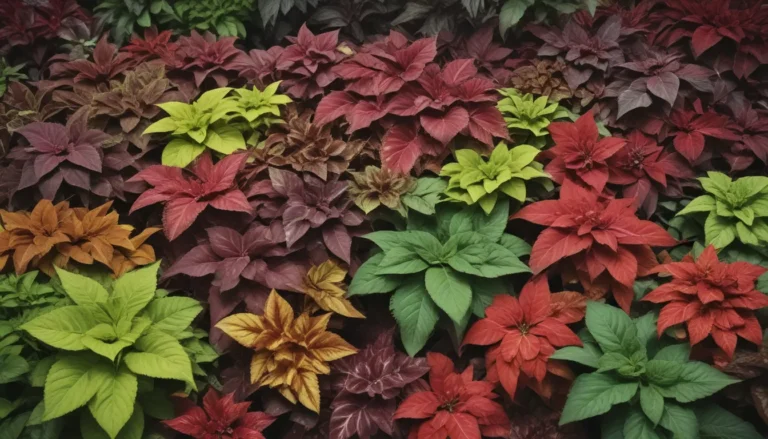Mastering the Art of Growing Horehound

Are you a fan of growing herbs in your garden? If so, you might want to consider adding horehound to your collection. Despite its somewhat bitter taste, this herb has a lot to offer. From being a key ingredient in making candy to being a natural pest deterrent, horehound is a versatile plant that can provide a range of benefits.
In this comprehensive guide, we’ll cover everything you need to know to successfully grow horehound in your garden. Whether you’re a seasoned gardener looking to expand your herb collection or a beginner eager to try your hand at growing this unique plant, this guide has you covered.
What You’ll Discover
- Cultivation and History: Learn about the origins of horehound and how it has been used throughout history.
- Propagation: Explore different methods for propagating horehound, from seed starting to root division.
- How to Grow: Understand the optimal conditions for growing horehound and tips for cultivating a healthy plant.
- Maintenance: Discover how to care for your horehound plants and ensure they thrive in your garden.
- Harvesting: Learn the best practices for harvesting horehound leaves and flowers for use in cooking and medicine.
- Preserving: Explore various methods for preserving horehound for long-term storage and use.
- Recipes and Use: Get creative with recipes and ideas for incorporating horehound into your culinary creations.
- Quick Reference Growing Guide: A handy reference chart summarizing key information about growing horehound.
Get ready to dive into the world of horehound and unlock the secrets to growing this unique herb in your garden!
Cultivation and History
Horehound, also known as Marrubium vulgare, is a perennial herb that has a long history of use in various cultures. Originating from Europe, North Africa, and Central and Western Asia, horehound has been cultivated for centuries for its medicinal and culinary properties.
Belonging to the mint family (Lamiaceae), horehound is a hardy plant that can thrive in a wide range of conditions. With its distinct gray-green leaves covered in fine hair, horehound is known for its unique appearance and potent aroma.
Despite its somewhat bitter taste, horehound has been valued for its medicinal properties, including its ability to ease coughs, indigestion, and colds. Additionally, horehound has been used as a flavoring agent in beer, candy, and tea, adding a distinctive taste to various culinary creations.
Propagation
When it comes to propagating horehound, there are several methods you can use to expand your plant collection:
- From Seed: Horehound seeds can be started indoors or sown directly into the garden. Cold stratification is essential for successful seed germination.
- Stem Cuttings: Easily propagate horehound by rooting stem cuttings in a suitable growing medium.
- Root Divisions: Divide mature horehound plants to create new growth and ensure the longevity of your garden.
- Layering: Use the layering technique to encourage new root growth and expand your horehound plant population.
By exploring these propagation methods, you can ensure a bountiful supply of horehound for your garden and culinary endeavors.
How to Grow
Growing horehound requires a few key considerations to ensure optimal plant health and growth:
- Full sun: Provide horehound plants with ample sunlight to promote vigorous growth.
- Well-draining soil: Plant horehound in soil that drains well to prevent waterlogging and root rot.
- Watering: Allow the top few inches of soil to dry out between waterings to prevent overwatering.
- Companion planting: Pair horehound with compatible plants like tomatoes to enhance growth and deter pests.
By following these growing tips, you can cultivate healthy horehound plants that thrive in your garden environment.
Maintenance
While horehound is a relatively low-maintenance plant, there are a few key tasks you can perform to keep your plants in top condition:
- Fertilization: Apply a balanced fertilizer once per year to promote healthy growth and development.
- Pruning: Periodically prune horehound plants to control growth and maintain plant health.
- Transplanting: Divide and transplant horehound plants as needed to prevent overcrowding and promote vigorous growth.
By incorporating these maintenance tasks into your gardening routine, you can ensure that your horehound plants flourish and provide a bountiful harvest.
Where to Buy and Horehound Relatives to Select
When selecting horehound plants or seeds for your garden, you can choose from common varieties like white horehound or explore related species that offer similar growing characteristics:
- Silver Edged Horehound: A drought-tolerant variety with ornamental foliage and silver undersides.
- Black Horehound: Known for its medicinal properties and purple-lavender flowers, this variety is a valuable addition to any herb garden.
By exploring these horehound relatives, you can create a diverse and visually appealing herb garden that offers a range of culinary and medicinal benefits.
Managing Pests and Disease
Horehound plants are relatively resistant to pests and diseases, making them an ideal choice for beginner and experienced gardeners alike:
- Natural deterrent: Horehound’s aromatic foliage deters common pests like aphids and grasshoppers.
- Companion planting: Use horehound as a companion plant to attract beneficial insects and deter harmful pests.
- Powdery mildew: Monitor for signs of powdery mildew and take appropriate measures to prevent its spread.
By implementing these pest management strategies, you can protect your horehound plants and ensure a healthy and productive garden.
Harvesting
When it comes to harvesting horehound leaves and flowers, timing is key to ensure optimal flavor and potency:
- Timing: Harvest horehound leaves and flowers when they are fully mature and at their peak flavor.
- Drying: Dry harvested horehound leaves and flowers to preserve their aroma and flavor for long-term use.
- Storage: Store dried horehound in a cool, dark place to maintain its freshness and potency over time.
By mastering the art of harvesting horehound, you can enjoy its distinctive flavor and aroma in a variety of culinary creations.
Preserving
Preserving horehound allows you to enjoy its unique flavor and aroma year-round:
- Drying: Dry horehound leaves and flowers to preserve their flavor and store them for extended periods.
- Freezing: Freeze horehound leaves for longer storage and retain their freshness for culinary use.
- Storage: Store dried horehound in airtight containers in a cool, dark place to maintain its quality and potency.
By following these preservation techniques, you can enjoy the benefits of horehound throughout the year in your favorite recipes.
Recipes and Use
From homemade candy to savory spice blends, horehound offers a range of culinary possibilities:
- Horehound candy: Make your own horehound candy using fresh or dried horehound leaves for a unique and flavorful treat.
- Savory spice: Add dried horehound leaves to meat, fish, and vegetable dishes for a smoky and aromatic flavor.
- Tea infusion: Use horehound leaves to create a soothing tea infusion that can help soothe coughs and digestive issues.
By exploring these recipes and culinary uses for horehound, you can elevate your cooking and enjoy the distinctive flavor of this versatile herb.
Quick Reference Growing Guide
To help you master the art of growing horehound, here is a quick reference guide summarizing key information about cultivating and caring for this unique herb:
- Plant Type: Perennial herb
- Native to: Central and Western Asia, Europe, North Africa
- Hardiness (USDA Zone): 3-9
- Exposure: Full sun to partial shade
- Spacing: 12 inches
- Height: Up to 30 inches
- Spread: 2-3 feet
- Water Needs: Low
- Common Pests and Disease: Mealybugs, spider mites; powdery mildew, root rot
By referencing this quick guide, you can quickly access essential information about growing horehound and ensure success in your herb garden.
Time to Give Horehound Its Due
Whether you’re a seasoned gardener or a novice enthusiast, growing horehound offers a range of benefits and opportunities. From its rich history to its diverse culinary and medicinal uses, horehound is a versatile and valuable addition to any garden.
By following the tips and techniques outlined in this guide, you can cultivate healthy and productive horehound plants that thrive in your garden environment. Whether you’re interested in making homemade candy, brewing tea, or simply enjoying the beauty of this unique herb, horehound is sure to become a staple in your herb collection.
So, what are you waiting for? Get ready to explore the world of horehound and unleash its full potential in your garden and kitchen. Let us know how you plan to use your homegrown horehound and share your experiences in the comments below!
In closing, horehound is a remarkable herb that offers a wealth of benefits and possibilities for gardeners and enthusiasts alike. By embracing its unique qualities and exploring its diverse uses, you can elevate your gardening experience and enjoy the distinct flavor and aroma of this versatile plant.
I hope you found this comprehensive guide to growing horehound informative and inspiring. By following the tips and techniques outlined in this article, you can cultivate a thriving horehound garden and enjoy the many benefits this versatile herb has to offer. If you have any questions or would like to share your horehound growing experiences, feel free to leave a comment below. Happy gardening!





